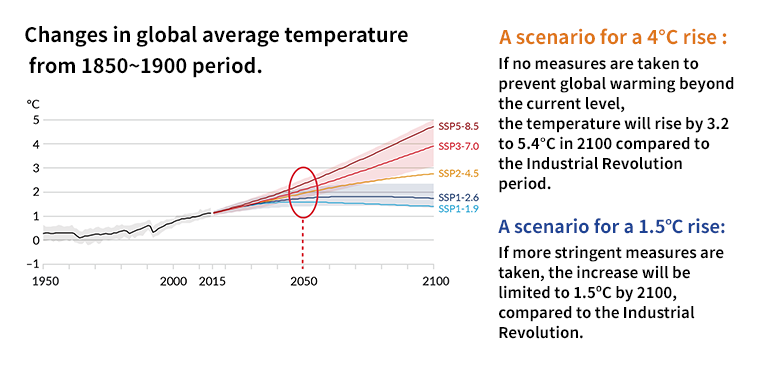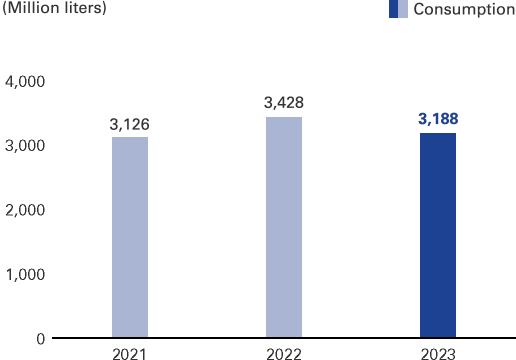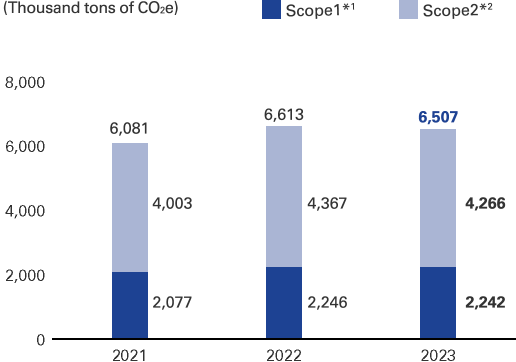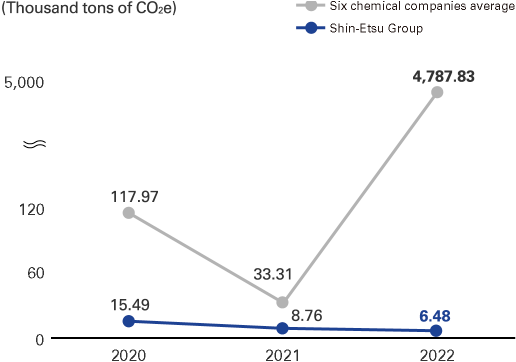Climate Change : TCFD Disclosure
Climate Change : TCFD Disclosure
Support for TCFD Recommendations
Support TCFD's recommendations In May 2019, the Shin-Etsu Group announced its support of the recommendations from the TCFD.*1 We also participated in the TCFD Consortium of Japan.*2 We will continue to share information regarding climate change in line with the TCFD recommendations.

*1TCFD
The Task Force on Climate-related Financial Disclosures (TCFD) is a special team focusing on climate change disclosure, and was established by the Financial Stability Board (FSB) in September 2015. In July 2017, the TCFD published a set of recommendations calling for corporations to analyze their risks and opportunities based on future scenarios and various mid to long-term predictions of climate change, and to disclose the impact on their finances.
*2TCFD Consortium of Japan
It is a group established by the Ministry of Economy, Trade and Industry, the Financial Services Agency, and the Ministry of the Environment in May 2019. Companies and financial institutions that agree with the recommendations from TCFD aim to promote the effective disclosure of information by companies and the efforts to link the disclosed information to appropriate investment decisions by financial institutions and other investors.
Disclosure of TCFD-Recommended Items
Governance
The Sustainability Committee is working with each of the Group's business divisions to address climate change.
The Sustainability Committee is one of the committees for each material management task in the Group's corporate governance system. Chaired by the president, the committee consists of about 60 members, including directors, corporate officers and divisional managers of Shin-Etsu Chemical, as well as persons in charge of sustainability at Group companies, and develop initiatives that integrate business and sustainability initiatives.
In FY2021, we established a Carbon Neutral Task Force within the Sustainability Committee to examine various issues related to climate change. The Task Force regularly reports the latest information to the president, who uses this report to determine policies for achieving carbon neutrality. In FY2022, the Task Force reported on climate change-related initiatives at the Managing Directors’ Meeting and the Board of Directors attended by all directors, audit & supervisory board members and corporate officers. In FY2023, the Task Force formulated a specific plan for achieving carbon neutrality by 2050, which was discussed and unanimously approved at the Managing Directors' Meeting.
Related information
Strategy
The Group considers the promotion of plans to achieve carbon neutrality by 2050 as an important management issue. While promoting information disclosure based on the TCFD recommendations, including scenario analysis, we identify important risks and opportunities that affect our business through these analyses, and reflect them in our management.
Scenario analysis of our business with respect to climate change
In FY2021, we conducted a scenario analysis of some of our businesses to identify the risks and opportunities that climate change poses to our business activities.
Assumed scenarios
Considering the impact of climate change, we have assumed scenarios for a 1.5°C rise and a 4°C rise for the year 2050.

Source: Sixth Assessment Report, Intergovernmental Panel on Climate Change (IPCC)
| Event | 1.5ºC scenario | 4ºC scenario |
|---|---|---|
| Extreme high temperatures on land areas | The frequency of extreme high temperatures (+1.9ºC compared to 1850–1900) on a once-in-a-decade scale will increase 4.1 times in 2081–2100. | The frequency of extreme high temperatures (+5.1ºC compared to 1850–1900) on a once-in-a-decade scale will increase 9.4 times in 2081–2100. |
| Heavy rainfall on land | The frequency of extreme wetting (+10.5% compared to 1850–1900) on a once-in-a-decade scale will increase 1.5 times in 2081–2100. | The frequency of extreme wetting (+30.2% compared to 1850–1900) on a once-in-a-decade scale will increase 2.7 times in 2081–2100. |
| Global mean sea level | Compared to the 1995–2014 average, global mean sea level will increase by 28 cm to 55 cm by 2100. | Compared to the 1995–2014 average, global mean sea level will increase by 63 cm to 101 cm by 2100. |
| Percentage of renewable energy in power supply composition | Renewable energy ratio will account for 90% of total electricity generation in 2050. | |
| Financial impact | Economic slowdown due to the introduction of the carbon tax and the impact of higher electricity prices on corporate profits. | Economic stagnation and increased insurance premiums due to severe wind and flood damage. |
Source: Sixth Assessment Report, Intergovernmental Panel on Climate Change (IPCC)
International Energy Agency (IEA) "Net Zero by 2050"
Mitsubishi Research Institute "Climate Change Response / Environmental Disclosure (TCFD)"
| Applications | Details | Revenue impact |
|---|---|---|
| Resin windows | Polyvinyl chloride resin is used for resin windows because of its excellent heat insulation properties. Demand for resin windows is expected to increase along with the spread of energy-saving homes. | Large |
| Electric vehicles, hybrid vehicles, fuel cell vehicles | Semiconductor silicon is used in power semiconductor devices such as inverters to control the number of rotations of motors, logic semiconductor devices for automatic driving system and AI. High-performance and compact rare-earth magnets can reduce the overall weight of a vehicle and improve its fuel efficiency, which will expand their use in the drive motors of electric, hybrid, and fuel cell vehicles, as well as in a variety of other motors in vehicles. Silicone heat-dissipating materials are used in lithium-ion batteries and various electronic control devices. Demand is expected to grow as it helps prevent malfunctions and failures caused by heat. | Large |
| Wind power generators | Demand for rare earth magnets is expected to grow as they contribute to higher efficiency in offshore wind turbines and lower maintenance costs for generators. | Large |
| Demand for vinyl chloride used for wire sheathing is also expected to increase due to the development and expansion of the power grid. | ||
| Air conditioners | Demand for semiconductor silicon is expanding as it is used in inverter control devices for compressor motors and contributes to power saving by adjusting the rotation speed of the motor to an appropriate level. | Medium |
| Demand for rare earth magnets is expected to grow as they improve the energy efficiency of air conditioner compressor motors and reduce energy consumption. | ||
| Aircrafts | Rare earth magnets are indispensable for the electrification and hybridization of small aircraft and for the electrification of hydraulic drive units in large aircraft. Demand for rare earth magnets is expected to increase as their small size and high power will help reduce the weight of the aircraft and improve fuel efficiency. | Medium |
| Motors for industrial use | Demand for rare earth magnets is expected to grow as they increase the efficiency of industrial motors and reduce the amount of electricity consumed. | Medium |
| Robots for services | Semiconductor silicon is increasingly being used in semiconductors for energy-saving robot control motors for manufacturing, logistics, agriculture, and other applications, as well as in medical and disaster response robots. | Medium |
| Binder for plant-based meat alternatives | A diet centered on plant-based foods may reduce CO2 emissions by 1.6 gigatons per year*. " Metolose MCE-100TS", one of the products of cellulose derivatives, is used as a binder for alternative meats derived from plants. The global market for plant-based meat is expected to grow at a double-digit rate annually, and further market expansion is expected. | Medium |
*From "DRAWDOWN – The Most Comprehensive Plan Ever Proposed to Reverse Global Warming" edited by Paul Hawken
| Events | Risks to the Company | Revenue impact | Countermeasures |
|---|---|---|---|
| Introduction of carbon taxes and establishment of carbon emission quotas around the world | Payment of carbon tax Incurring costs of purchasing emission credits to meet carbon emission quotas Increased costs of measures to reduce greenhouse gas emissions |
Large | Reduce scope 1 emissions
Collection of information on environmental regulations such as carbon taxes in each country and implementation of countermeasures |
| Widespread use of electricity derived from renewable energy sources and rising electricity prices resulting from tightening regulations on greenhouse gas emissions | Increase in electricity costs | Large | Reduce scope 2 emissions
|
| Events | Risks to the Company | Revenue impact | Countermeasures |
|---|---|---|---|
| Increase in the frequency of extreme weather events | Flooding of production sites Disruption of the supply chain |
Large | Raising the ground level of production sites, installation of watertight walls around critical facilities, installation of instrument rooms in areas with low risk of flooding, installation of seawalls at production sites close to ports Multiple production bases Diversification of raw material procurement sources Securing product inventory Enrollment in damage insurance |
| Increased frequency of flooding caused by changes in precipitation patterns, etc. | |||
| Introduction of carbon taxes and establishment of carbon emission quotas in some countries | Payment of carbon tax imposed on greenhouse gases emitted from production sites in the said countries Costs of purchasing emission credits and payment of surcharges will be incurred if our greenhouse gas emissions do not meet the carbon emission targets established by the said countries. |
Small | Reduce scope 1 emissions
Collection of information on environmental regulations such as carbon taxes in each country and implementation of countermeasures |
| Electricity price | According to the IEA scenario analysis (current measures scenario), electricity prices will not increase. Therefore, there is no risk to the Company. | — | — |
Risk Management
The Risk Management Committee works to prepare for and eliminate the various risks surrounding our business, including risks posed by climate change. The Committee is chaired by a managing corporate officer and consists of approximately 20 members, including our directors, corporate officers, and department managers. Our Group has established Risk Management Regulations to identify potential risks associated with our business activities and address these risks appropriately. The Risk Management Regulations clearly state specific risks, risk management systems, and responses to risks that materialize. The Risk Management Committee reports to the Board of Directors, Managing Directors’ Meeting, Audit & Supervisory Board, and relevant parties in a timely manner on important risk management issues, and works to address them appropriately. With regard to the risks related to climate change, which have become increasingly important in recent years, the Sustainability Committee works with the Risk Management Committee to ascertain risks through scenario analysis.
Climate-related physical risks include increased spending due to CO2 emissions trading and carbon taxes, transition risks such as rising manufacturing costs due to rising energy prices, damage to equipment due to the wind disaster, and damage to electrical equipment due to flooding, or plant shutdown resulting from such cases.
Among these risks, we defined serious risks such as accidents, explosions, fires, and other major disasters that cause operations to be stopped for one day or more, and environmental pollution incidents that exceed legal standards values or regulation values.
Related information
Metrics and Targets
The Shin-Etsu Group aims to achieve net zero greenhouse gas emissions (Scope 1 and 2) by 2050.
Furthermore, we will continue to promote the reduction of greenhouse gas emissions in terms of intensity. We will work to achieve the new medium-term target set in FY2016 of “Reduce greenhouse gas emissions in terms of intensity to 45% of the FY1990 level by FY2025.”
Long-term target
Achieve carbon neutrality by 2050 (scopes 1 and 2)
Result in FY2023
6,507 thousand t-CO2 (scope1 2,242 thousand t-CO2, scope2 4,266 thousand t-CO2)
Mid-term target
Reduce greenhouse gas emissions in terms of production intensity to 45% (i.e. down 55%) of the FY1990 level by FY2025. *1
Result in FY2023
Achieves reduction to 57.0% (i.e. down 43.0%) for the Shin-Etsu Group*2 and 53.4% (i.e. down 46.6%) for Shin-Etsu Chemical.
FY2023 target
Reduce energy consumption in terms of production intensity at an average annual rate of 1%
Result in FY2023
The average annual reduction rate from FY2020 to FY2023 was 0.3% increased
We continued to promote energy-saving activities at each plant in FY 2023. On the other hand, although production volume decreased in FY2023, production volume intensity increased due to the impact of fixed energy consumption (clean rooms, air conditioning, lighting, etc.) that is not proportional to production volume.
Changes in Greenhouse Gas Emissions in Terms of Production Intensity Relative to the FY1990 Level

*1For the calculation of emissions, CO2 emission factors for electricity are averaged from 2000 to 2009 so that efforts to reduce electricity can be clarified. Furthermore, to clarify our efforts in energy reduction and rationalization, the figures do not include additional emissions categories associated with the amendments to Japan's Act on Promotion of Global Warming Countermeasures that took effect in 2024.
*2Includes non-consolidated group companies.
Energy Consumption (crude oil equivalent)

Greenhouse Gas Emission Volume Trends

*1Scope 1 : Direct emissions from facilities you own or control (e.g., fuel oil, natural gas)
*2Scope 2 : Emissions from the production of energy purchased by the company (e.g., purchased electricity, steam)
Greenhouse Gas Emission Volume Trends(Ordinary income intensity)*3

*3
・Ordinary income intensity = emissions (CO2-ton) / consolidated or non-consolidated ordinary income (million yen)
・Scope of calculation for 5 chemical companies other than Shin-Etsu: 4 consolidated companies and 1 major group company
Scope 3 Greenhouse Gas Emissions
The Group's Scope 3 greenhouse gas emissions*1 for FY2023 were 10,866 thousand tons of CO2, amounting to 63% of the supply chain*2’s total emissions.
*1Scope 3: Emissions from the supply chain
*2Supply chain
All stages of a product life from raw material production until the product is discarded.
| Category | Category definitions | Emissions (Unit: 1,000 tons of CO2) |
Amount of activity | Source of emission intensity used |
|---|---|---|---|---|
| 1. Purchased goods and services | Emissions from activities up to the time raw materials, parts, purchased goods, and materials for sale are manufactured | 5,275 | Amount of raw materials, etc. purchased | Emission intensity obtained from suppliers IDEA v2 Ministry of the Environment Emission Intensity Database (Ver. 3.4) |
| 2. Capital goods | Emissions from the construction and manufacture of the company’s capital goods | 1,111 | Increase in tangible and intangible fixed assets | Ministry of the Environment Emission Intensity Database (Ver. 3.4) |
| 3. Fuel- and energy-related activities not included in Scope 1 and 2 | Emissions from the mining, refining, etc. of procured fuel Emissions associated with the mining and refining of fuels used to generate procured electricity |
928 | Total energy purchased | Ministry of the Environment Emission Intensity Database (Ver. 3.4) |
| 4. Transportation and distribution (upstream) | (1) Emissions associated with the distribution to the company of products and services purchased from suppliers during the reporting year | 684 | Weight of purchased raw materials and transport distance of raw materials | Act on Rationalizing Energy Use (ton-kilo method) IDEA v2 |
| (2) Emissions associated with logistics services other than those in (1) purchased during the reporting year (emissions associated with logistics for which the company bears the costs) | Volume and distance of products transported (at our expense) | Act on Rationalizing Energy Use (ton-kilo method) | ||
| 5. Waste generated in operations | Emissions from the transportation and end-of-life treatment of waste generated by the company | 43 | Amount of waste by type | Ministry of the Environment Emission Intensity Database (Ver. 3.4) |
| 6. Business travel | Emissions associated with employee business travels | 3 | Total number of travel days by type | Ministry of the Environment Emission Intensity Database (Ver. 3.4) |
| 7. Employee commuting | Emissions from employees commuting to and from the office | 25 | Commuter passes and other commuting expenses | Ministry of the Environment Emission Intensity Database (Ver. 3.4) |
| 8. Leased assets (upstream) | Emissions from the operation of leased assets leased by the company | — | What are excluded from the calculation At the Group, leasing transactions by overseas non-production facilities are subject to the calculation, but there was no materiality. |
|
| 9. Transportation and distribution (downstream) | Emissions associated with the distribution of products sold by the company to final consumers (for which the company does not bear the cost) | 225 | Volume of products and how far they are transported (at the expense of the customer) | Act on Rationalizing Energy Use (ton-kilo method) IDEA v2 |
| 10. Processing of sold products | Emissions from the processing of intermediate products by businesses | — | Not applicable The WBCSD Chemical Sector Guidelines apply, which state: “Chemical companies are not required to report scope 3, category 10 emissions, since reliable figures are difficult to obtain due to the diverse application and customer structure.” |
|
| 11. Use of sold products | Emissions associated with the use of products by users (consumers and businesses) | — | Not applicable The WBCSD Chemical Sector Guidelines apply, which state: “Chemical companies should not include indirect use-phase emissions in the inventory, unless the end use of chemical products is known.” |
|
| 12. End-of-life treatment of sold products | Emissions resulting from the end-of-life treatment of products by users (consumers and businesses) | 2,572 | Volume of products sold | Ministry of the Environment Emission Intensity Database (Ver. 3.4) IDEA v2 |
| 13. Leased assets (downstream) | Emissions from the operation of leased assets leased to others | — | Not applicable The Company has no assets leased to other companies. |
|
| 14. Franchises | Emissions at franchisees | — | Not applicable The Company is not a franchise owner. |
|
| 15. Investments | Emissions associated with the management of investments | — | Not applicable There is no profit-seeking investment. |
|
| Total Scope 3 emissions | 10,866 | |||
*Starting in FY2022, we changed the emission factor for raw material procurement in Category 1 and the emission factors for marine transportation in Categories 4-(1) and 9.
Scope 1, 2, and 3 emissions flows (unit: 1,000 t-CO2)
![figure: [Upstream of supply chain 8,069]
1. Purchased goods and services
2. Capital goods
3. Fuel- and energy-related activities not included in Scope 1 and 2
4. Transportation and distribution (upstream)
5. Waste generated in operations
6. Business travel
7. Employee commuting
Scope1 [2,242]
Scope2 [4,266]
9. Transportation and distribution (downstream)
12. End-of-life treatment of sold products
[Downstream of supply chain 2,798]](/en/sustainability/assets/images/esg_environment/global_warming/img03_02_4_e.png)
Key Sustainability Issues
- The foundation of all activities: legal compliance, fair corporate activities
- Health and safety of employees and contractors
- Energy-saving, resource-saving, and reduction of the environmental impacts
- Product quality improvements and product safety control
- Promoting CSR procurement and the diversification of supply sources
- Respect for human rights, the development of human resources, and the promotion of diversity
- Respect for and protection of intellectual property
- Contribution to industry and social initiatives
- Accurate and timely information disclosure and communication with stakeholders
